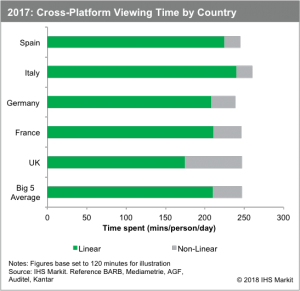IHS: linear TV viewing down as online time increases
Linear TV viewing time declined year-on-year across the top five European markets in 2017 as the share of viewing time for online platforms increased, according to IHS Markit.
 The research firm noted that video consumption is changing across the leading five European markets – the UK, France, Germany, Italy and Spain – with time-shifted viewing via personal video recorders also stagnating or declining last year.
The research firm noted that video consumption is changing across the leading five European markets – the UK, France, Germany, Italy and Spain – with time-shifted viewing via personal video recorders also stagnating or declining last year.
The research found that viewers spent an average of 10 minutes per-person per-day devoted to online short-form video content of up to 15 minutes in length, and eight minutes watching long-form content over 15 minutes in length.
UK viewers were found to spend more time watching non-linear content than people in the other four markets. Online long-form consumption grew 21% percent, rising three minutes per-person per-day since 2016. Meanwhile, subscription over-the-top services accounted for 74% of viewing minutes, compared to 69% in 2016.
At the same time, UK daily linear viewing time declined by more than eight minutes per person in 2017, as PVR time shifting also declined for the second consecutive year, said the report.
In France online long-form viewing time was found to have increased by 41.6% year-over-year in 2017, or by approximately five additional viewing minutes per-person per-day. Netflix accounted for three out of four French OTT subscriptions in 2017, while CanalPlay experienced subscription declined.
“The shift to OTT consumption signals the need for pay TV operators to act quickly, in order to retain their foothold in the market,” said Rob Moyser, TV and online video analyst, IHS Markit.
“Leading operators are already enhancing their current propositions and embracing OTT, to ensure they capture some of the time spent on other devices and services, so they can stay at the forefront of consumers’ minds.”
IHS Markit’s associate director of connected devices and media consumption, Fateha Begum, said: “With the increasing volume of consumption moving away from traditional linear broadcast, monetisation of on-demand and time-shifted viewing remains a key concern, as ad-insertion and tracking technology has been slow to keep up. However, pay TV operators are still primarily concerned with retaining subscription revenues, for the time being.”



